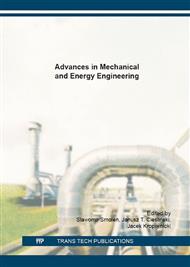p.181
p.188
p.198
p.208
p.216
p.223
p.235
p.245
p.256
Possibilities of the Use of the Electrolytic Technique for the Investigations of Mass/Heat Transfer in Nanofluid
Abstract:
In the paper the author presents the possibilities of the application of the electrolytic technique for the investigation of heat transfer coefficients in channels with nanofluids. The electrolytic technique called the limiting current method enables to obtain mass transfer coefficients on the basis of the electrochemical processes and the laws governing these physical phenomena. The exemplary graph presenting the limiting currents values resulting from the experiment is shown in Fig. 1. These are the voltammograms at different Reynolds numbers and the ion concentration Cb. Heat transfer coefficients can be calculated using the correlations describing the analogy of mass and heat transfer processes. Some cases of the possible application of the electrolytic technique and factors influencing the mass transfer experiment including the state of the electroactive surface, change in ion concentration and thickness of the diffusion layer are discussed in [1]. In this work the author focused on the mass transfer experiment with the application of the nanofluid. Special properties of the nanofluid should be taken into account in the investigations. The paper presents the preliminary results of the experiment with nanofluid in the annular channel.
Info:
Periodical:
Pages:
216-222
Citation:
Online since:
April 2016
Authors:
Price:
Сopyright:
© 2016 Trans Tech Publications Ltd. All Rights Reserved
Share:
Citation:


